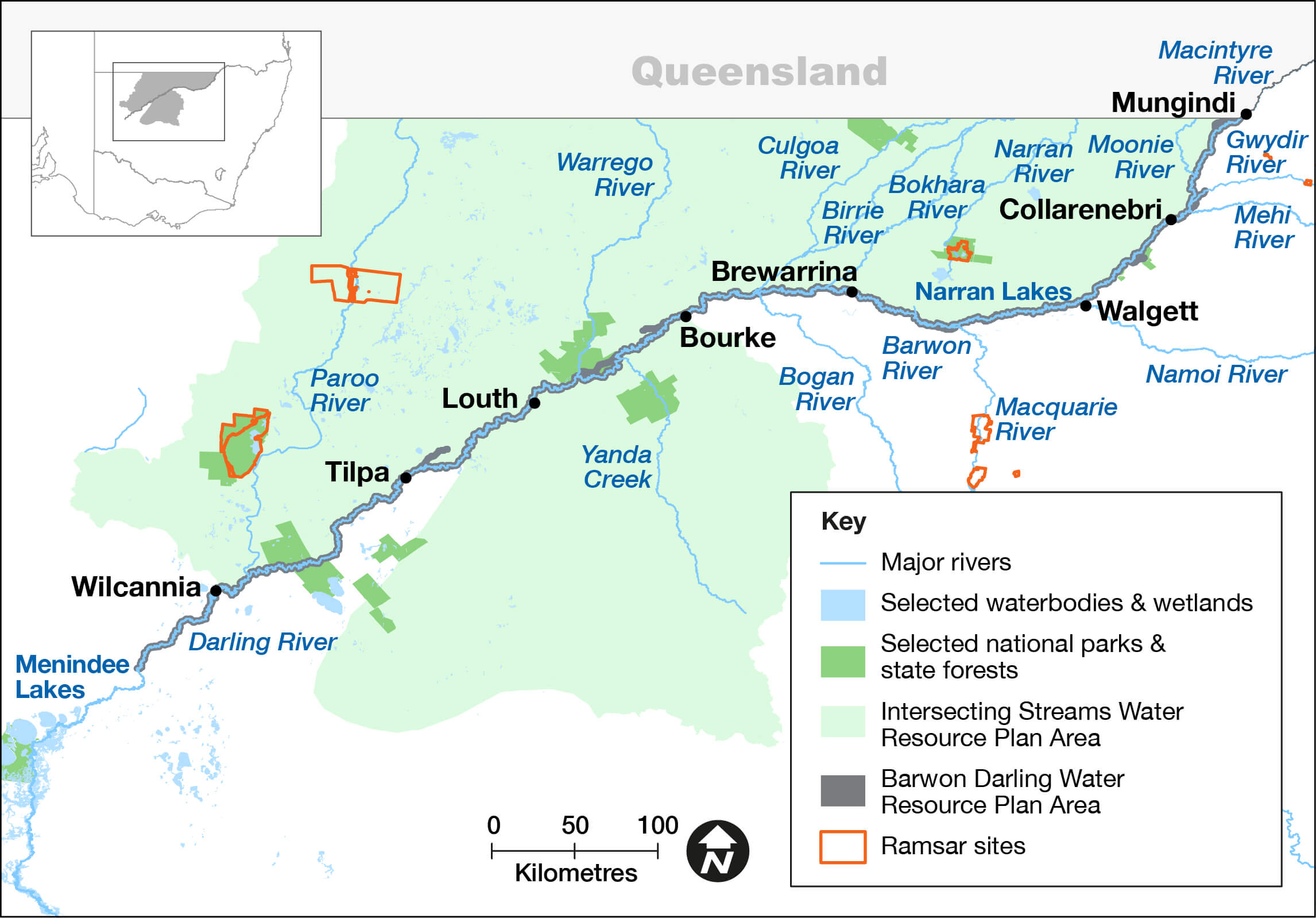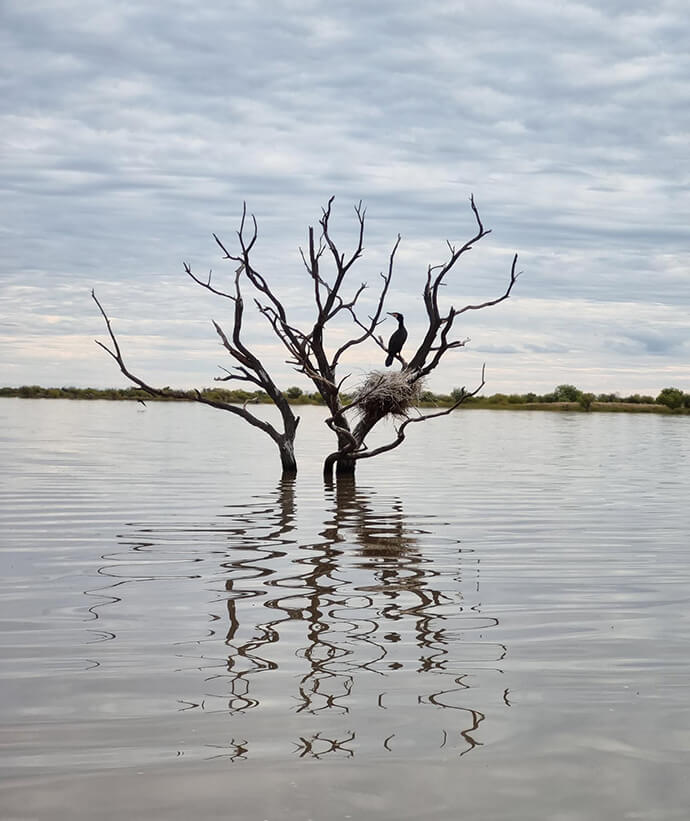Waterbird breeding and river connectivity were the focus for environmental water management in the Intersecting Streams catchment in 2021–22.
Key outcomes
Under wet to very wet conditions, environmental water managers worked with partner agencies to coordinate the protection of water for the environment in the Intersecting Streams catchment to:
- help sustain waterbird breeding colonies at Narran Lakes
- improve system connectivity between the Condamine–Balonne rivers and the connected Culgoa–Birrie–Bokhara–Narran system
- improve the condition of wetland vegetation at Narran Lakes
- inundate a significant area of the western floodplain at Toorale National Park and State Conservation Area and provide connection from the Warrego to Darling River
- inundate significant areas of wetlands along the Paroo River.

Intersecting Streams catchment area map.
Catchment conditions
During the 2021–22 year the Intersecting Streams catchment experienced La Niña weather conditions, which resulted in high rainfall and moderate temperatures. Extended periods of high flow occurred across much of the catchment, and in parallel to the Condamine–Balonne catchment in Queensland. This triggered the Commonwealth’s Queensland environmental water entitlements.
About the catchment
The Intersecting Streams catchment is in north-western New South Wales and covers an area of 120,431 square kilometres. Located in a semi-arid climate zone, rainfall is typically associated with northern summer monsoonal weather. The area comprises 4 key river systems: the Paroo and Warrego rivers, the Culgoa–Birrie–Bokhara–Narran connected system and Moonie River that originates in Queensland and connects with the Barwon–Darling in wet years.
The Intersecting Streams catchment includes ephemeral streams and wetlands. Three wetlands in the Intersecting Streams catchment are Ramsar sites, while others are listed in the Directory of Important Wetlands and identified by Birdlife Australia as important bird areas.
Traditional owners
The Intersecting Streams catchment is Country to the Barkindji, Budjiti, Euahlayi, Guwamu/Kooma, Gomeroi/Kamilaroi, Ngiyampaa, Kunja, Murrawarri and Ngemba First Nations.
Watering aims
The Intersecting Streams Catchment – Water for the Environment: Annual Priorities 2021–22 was developed under a dry to moderate resource availability scenario. Objectives were to:
- support stocks of native fish and provide opportunities for them to breed and disperse into secure habitats
- increase the duration of inundation of water-dependent vegetation at Narran Lakes
- increase the duration of inundation of water-dependent vegetation on the western floodplain at Toorale
- ensure adequate vegetation condition and water level should further inflows trigger a colonial waterbird breeding event in spring 2021.
With wet to very wet conditions, water managers used an adaptive approach to improve opportunities for plants and animals to breed, move and thrive, and restore key floodplain and wetland linkages.
Water delivery
The Commonwealth Environmental Water Holder coordinated the protection of 317 gigalitres of water for the environment from Queensland, which resulted in 127 gigalitres of Commonwealth-held environmental water crossing into NSW rivers. Figures are accurate at the date of publishing, but may be adjusted.
Outcomes
In the 2021–22 water year, much of the Intersecting Streams catchment did not require intervention because of high flow events.
The Commonwealth protected water for the environment in the Condamine–Balonne system, which contributed to significant flow events in the connected Culgoa–Birrie–Bokhara–Narran system.
Narran Lakes received inflows totalling more than 700 gigalitres. This supported:
- waterbird breeding and vegetation condition
- native fish movement and recruitment
- lateral and longitudinal system connectivity.
Management of Warrego River flows at Toorale under the Construction Environment Management Plan, saw inundation of the western floodplain and connection with the Darling River from both the Warrego main channel and the western floodplain. Vegetation monitoring by the Flow-MER program found improved lignum condition at monitoring sites on the western floodplain.
Flows from the Warrego River also entered the Cuttaburra Channel inundating the wetland areas of Yantabulla Swamp. Rainfall in south-western Queensland and north-western New South Wales resulted in significant flows through the Paroo River system and inundation of wetlands at Nocoleche Nature Reserve and Paroo Darling National Park.
Case study: Colonial nesting waterbirds flock to Narran Lakes for the first time in a decade
For the first time in 10 years, colonial waterbirds such as straw-necked ibis, royal spoonbill, little pied cormorants and Australasian darters have bred at Narran Lakes.
About 10,000 colonial waterbird nests were recorded in this event over the summer of 2021–22.
Natural flows, including water protected under Commonwealth Environmental Water Holder (CEWH) Queensland entitlements, helped fill and sustain the Narran Lakes and provide suitable conditions for the colonial waterbirds to breed. In total more than 700 gigalitres entered the Narran Lakes system in the 2021–22 water year.
The Narran Waterbird Technical Advisory Group was established to provide advice on the condition of the site, status of the colony and environmental watering needs. The colony sites were on Narran Lakes Nature Reserve and we monitored these in collaboration with CEWH and the University of New South Wales.
Despite planning, natural inflows negated the need to use the event-based mechanism to compensate irrigators or release water from their storages.
Compared with some historical events this was a relatively small breeding event. However, with continued wet conditions and inflows from the Queensland Condamine–Balonne catchment, there is strong potential for colonial waterbird breeding again in the spring and summer of 2022–23.

Narran lakes flood area.